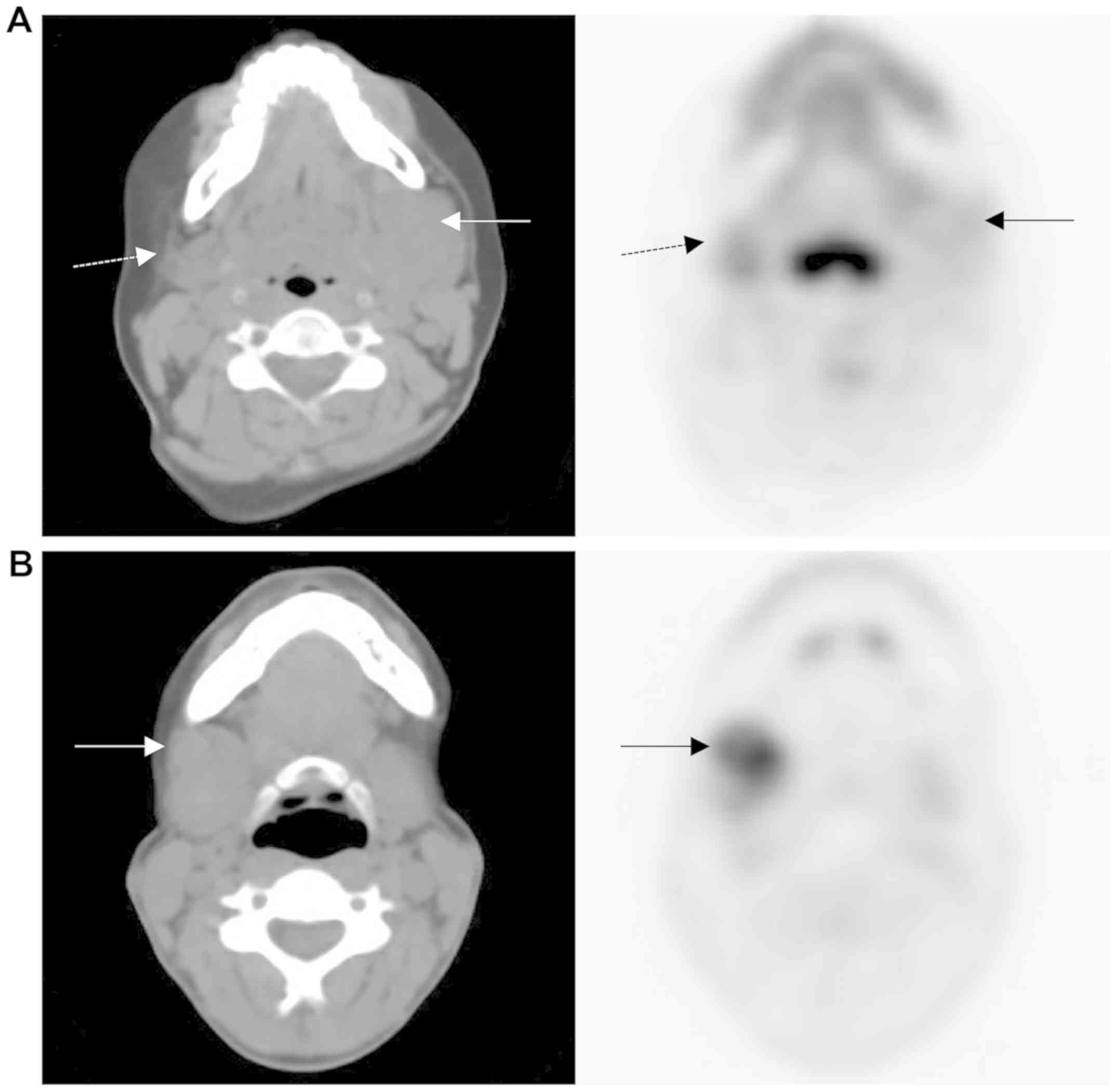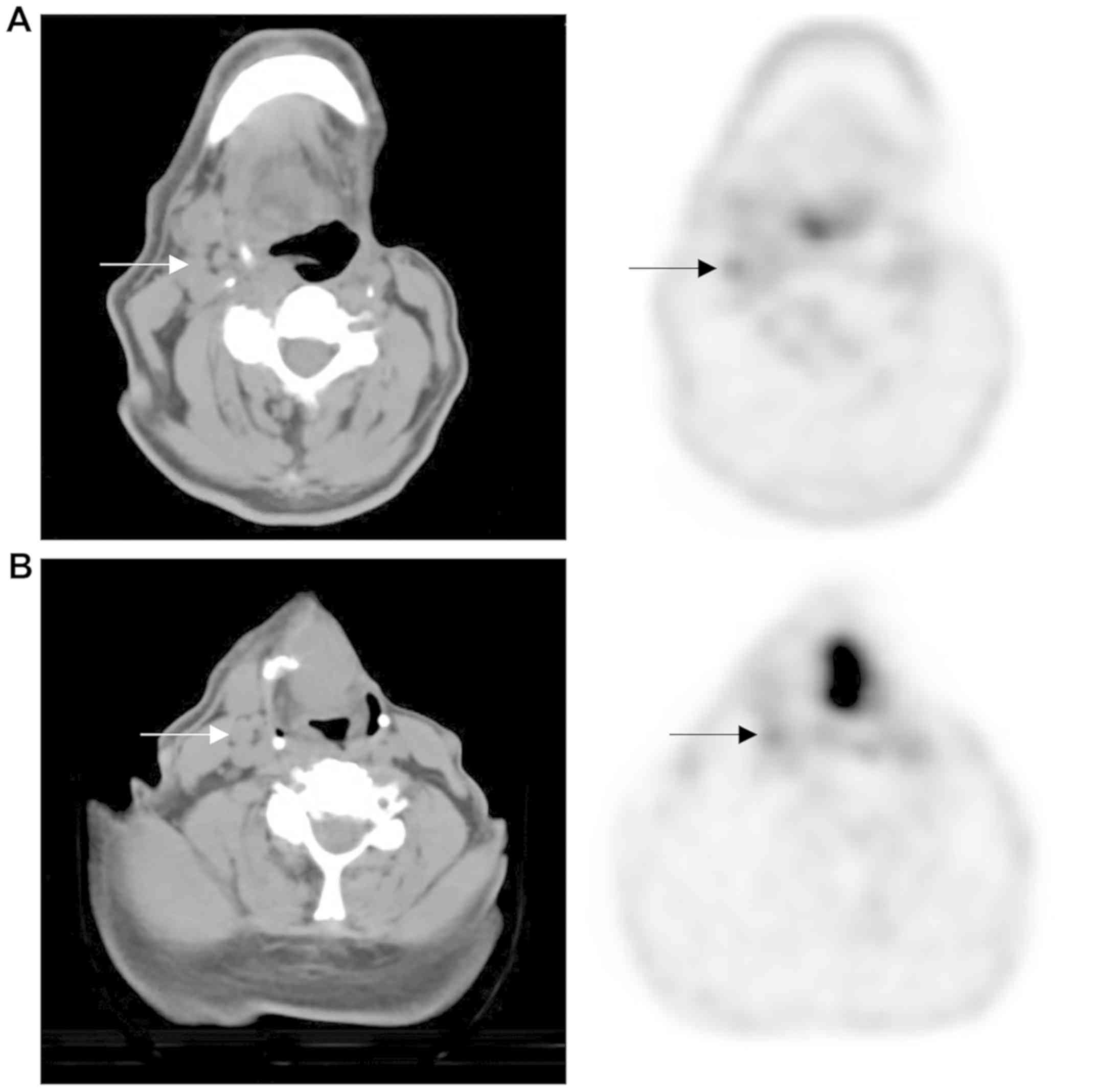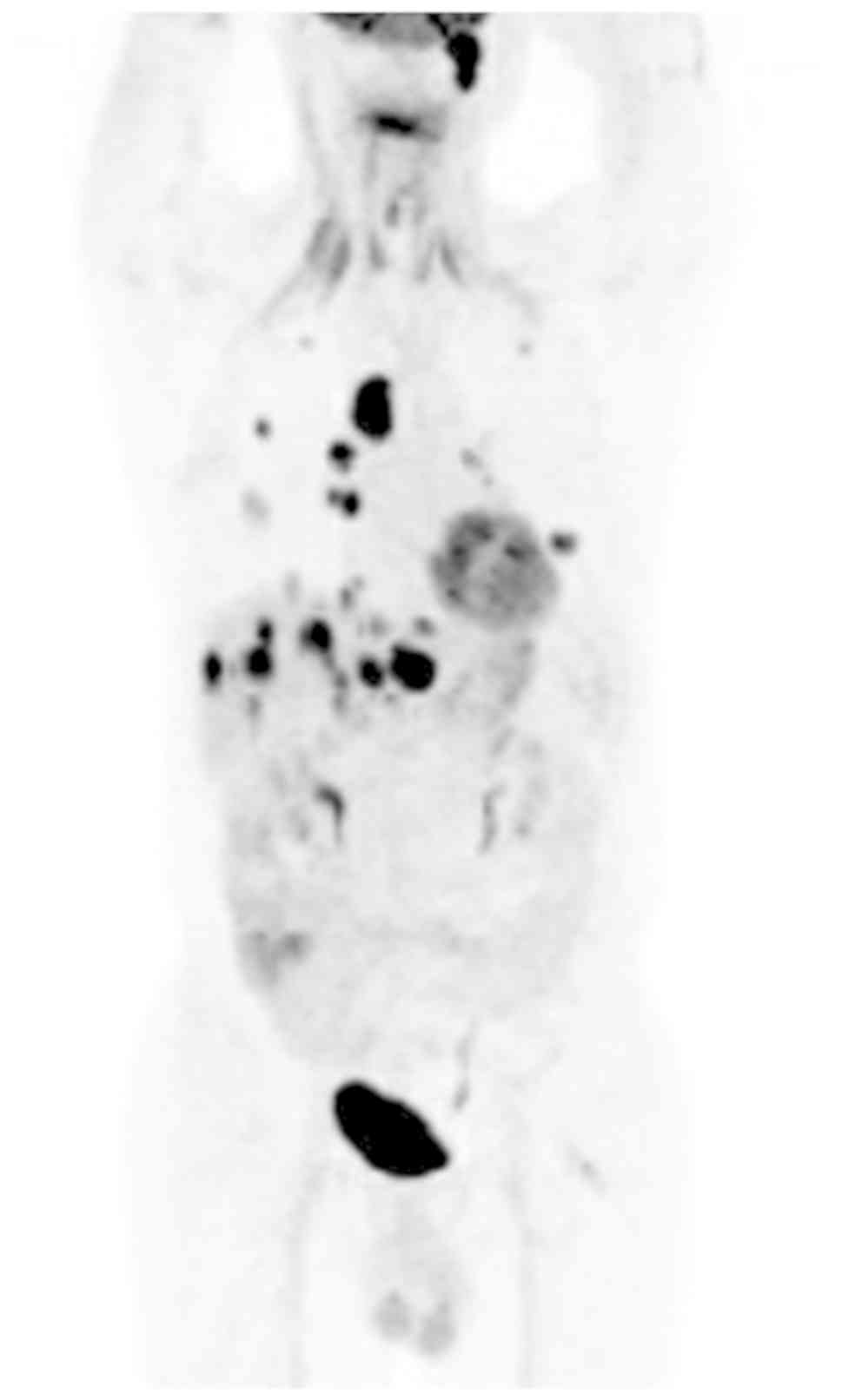|
1
|
Guzzo M, Locati LD, Prott FJ, Gatta G,
McGurk M and Licitra L: Major and minor salivary gland tumors. Crit
Rev Oncol Hematol. 74:134–148. 2010.PubMed/NCBI View Article : Google Scholar
|
|
2
|
Pinkston JA and Cole P: Incidence rates of
salivary gland tumors: Results from a population-based study.
Otolaryngol Head Neck Surg. 120:834–840. 1999.PubMed/NCBI View Article : Google Scholar
|
|
3
|
Han MW, Cho KJ, Roh JL, Choi SH, Nam SY
and Kim SY: Patterns of lymph node metastasis and their influence
on outcomes in patients with submandibular gland carcinoma. J Surg
Oncol. 106:475–480. 2012.PubMed/NCBI View Article : Google Scholar
|
|
4
|
Aro K, Ho AS, Luu M, Kim S, Tighiouart M,
Clair JM, Yoshida EJ, Shiao SL, Leivo I and Zumsteg ZS: Development
of a novel salivary gland cancer lymph node staging system. Cancer.
124:3171–3180. 2018.PubMed/NCBI View Article : Google Scholar
|
|
5
|
Ali S, Palmer FL, Yu C, DiLorenzo M, Shah
JP, Kattan MW, Patel SG and Ganly I: Postoperative nomograms
predictive of survival after surgical management of malignant
tumors of the major salivary glands. Ann Surg Oncol. 21:637–642.
2014.PubMed/NCBI View Article : Google Scholar
|
|
6
|
Koyuncu M, Sesen T, Akan H, Ismailoglu AA,
Tanyeri Y, Tekat A, Unal R and Incesu L: Comparison of computed
tomography and magnetic resonance imaging in the diagnosis of
parotid tumors. Otolaryngol Head Neck Surg. 129:726–732.
2003.PubMed/NCBI View Article : Google Scholar
|
|
7
|
Freling N, Crippa F and Maroldi R: Staging
and follow-up of high-grade malignant salivary gland tumours: The
role of traditional versus functional imaging approaches-A review.
Oral Oncol. 60:157–166. 2016.PubMed/NCBI View Article : Google Scholar
|
|
8
|
Rudack C, Jörg S, Kloska S, Stoll W and
Thiede O: Neither MRI, CT nor US is superior to diagnose tumors in
the salivary glands-An extended case study. Head Face Med.
3(19)2007.PubMed/NCBI View Article : Google Scholar
|
|
9
|
Afzelius P, Nielsen MY, Ewertsen C and
Bloch KP: Imaging of the major salivary glands. Clin Physiol Funct
Imaging. 36:1–10. 2016.PubMed/NCBI View Article : Google Scholar
|
|
10
|
Kessler AT and Bhatt AA: Review of the
major and minor salivary glands, Part 2: Neoplasms and tumor-like
lesions. J Clin Imaging Sci. 8(48)2018.PubMed/NCBI View Article : Google Scholar
|
|
11
|
Mayerhoefer ME, Prosch H, Beer L, Tamandl
D, Beyer T, Hoeller C, Berzaczy D, Raderer M, Preusser M, Hochmair
M, et al: PET/MRI versus PET/CT in oncology: A prospective
single-center study of 330 examinations focusing on implications
for patient management and cost considerations. Eur J Nucl Med Mol
Imaging. 47:51–60. 2020.PubMed/NCBI View Article : Google Scholar
|
|
12
|
Cicero G, D'angelo T, Racchiusa S,
Salamone I, Visalli C, Bottari A, Blandino A and Mazziotti S:
Cross-sectional imaging of parotid gland nodules: A brief practical
guide. J Clin Imaging Sci. 8(14)2018.PubMed/NCBI View Article : Google Scholar
|
|
13
|
Liu Y, Li H, Qin L, Huang X, Su M and Han
Z: Prognostic factors in malignant sublingual salivary gland
tumors. J Oral Maxillofac Surg. 75:1542–1548. 2017.PubMed/NCBI View Article : Google Scholar
|
|
14
|
Pfister DG, Spender S, Brizel DM, Burtness
B, Busse PM, Caudell JJ, Cmelak AJ, ColevasAD Dunphy F, Eisele DW,
et al: Head and Neck Cancers, Version 2.2014. Clinical Practice
Guidelines in Oncology. J Natl Compr Canc Netw. 12:1454–1487.
2014.PubMed/NCBI View Article : Google Scholar
|
|
15
|
Sharma P, Jain TK, Singh H, Suman SK,
Faizi NA and Kumar R, Bal C, Malhotra A and Kumar R: Utility of
(18)F-FDG PET-CT in staging and restaging of patients with
malignant salivary gland tumours: A single-institutional
experience. Nucl Med Commun. 34:211–219. 2013.PubMed/NCBI View Article : Google Scholar
|
|
16
|
Roh JL, Ryu CH, Choi SH, Kim JS, Lee JH,
Cho KJ, Nam SY and Kim SY: Clinical utility of 18F-FDG PET for
patients with salivary gland malignancies. J Nucl Med. 48:240–246.
2007.PubMed/NCBI
|
|
17
|
Kinahan PE and Fletcher JW: Positron
emission tomography-computed tomography standardized uptake values
in clinical practice and assessing response to therapy. Semin
Ultrasound CT MR. 31:496–505. 2010.PubMed/NCBI View Article : Google Scholar
|
|
18
|
Benz MR, Allen-Auerbach MS, Eilber FC,
Chen HJ, Dry S, Phelps ME, Czernin J and Weber WA: Combined
assessment of metabolic and volumetric changes for assessment of
tumor response in patients with soft-tissue sarcomas. J Nucl Med.
49:1579–1584. 2008.PubMed/NCBI View Article : Google Scholar
|
|
19
|
Diao W, Tian F and Jia Z: The prognostic
value of SUVmax measuring on primary lesion and ALN by
18F-FDG PET or PET/CT in patients with breast cancer.
Eur J Radiol. 105:1–7. 2018.PubMed/NCBI View Article : Google Scholar
|
|
20
|
Cheng NM, Hsieh CE, Liao CT, Ng SH, Wang
HM, Fang YD, Chou WC, Lin CY and Yen TC: Prognostic value of tumor
heterogeneity and SUVmax of Pretreatment 18F-FDG PET/CT for
salivary gland carcinoma with high-risk histology. Clin Nucl Med.
44:351–358. 2019.PubMed/NCBI View Article : Google Scholar
|
|
21
|
Thoeny HC: Imaging of salivary gland
tumours. Cancer Imaging. 7:52–62. 2007.PubMed/NCBI View Article : Google Scholar
|
|
22
|
Ruhlmann V, Poeppel TD, Veit J, Nagarajah
J, Umutlu L, Hoffmann TK, Bockisch A, Herrmann K and Sauerwein W:
Diagnostic accuracy of 18F-FDG PET/CT and MR imaging in
patients with adenoid cystic carcinoma. BMC Cancer.
17(887)2017.PubMed/NCBI View Article : Google Scholar
|
|
23
|
Purohit BS, Ailianou A, Dulguerov N,
Becker CD, Ratib O and Becker M: FDG-PET/CT pitfalls in oncological
head and neck imaging. Insights Imaging. 5:585–602. 2014.PubMed/NCBI View Article : Google Scholar
|
|
24
|
Lee SH, Roh JL, Kim JS, Lee JH, Choi SH,
Nam SY and Kim SY: Detection of distant metastasis and prognostic
prediction of recurrent salivary gland carcinomas using
18F-FDG PET/CT. Oral Dis. 24:940–947. 2018.PubMed/NCBI View Article : Google Scholar
|
|
25
|
Park MJ, Oh JS, Roh JL, Kim JS, Lee JH,
Nam SY and Kim SY: 18F-FDG PET/CT Versus Contrast-Enhanced CT for
staging and prognostic prediction in patients with salivary gland
carcinomas. Clin Nucl Med. 42:e149–e156. 2017.PubMed/NCBI View Article : Google Scholar
|
|
26
|
Bertagna F, Nicolai P, Maroldi R,
Mattavelli D, Bertoli M, Giubbini R, Lombardi D and Treglia G:
Diagnostic role of (18)F-FDG-PET or PET/CT in salivary gland
tumors: A systematic review. Rev Esp Med Nucl Imagen Mol.
34:295–302. 2015.PubMed/NCBI
|
|
27
|
Bhargava P, Rahman S and Wendt J: Atlas of
confounding factors in head and neck PET/CT imaging. Clin Nucl Med.
36:e20–e29. 2011.PubMed/NCBI View Article : Google Scholar
|
|
28
|
Palacios E, Ellis M, Lam EC, Neitzschman H
and Haile M: Pitfalls in imaging the submandibular glands with
PET/CT. Ear Nose Throat J. 94:E37–E39. 2015.PubMed/NCBI
|
|
29
|
Kendi AT, Magliocca KR, Corey A, Galt JR,
Switchenko J, Wadsworth JT, El-Deiry MW, Schuster DM, Saba NF and
Hudgins PA: Is there a role for PET/CT parameters to characterize
benign, malignant, and metastatic parotid tumors? AJR Am J
Roentgenol. 207:635–640. 2016.PubMed/NCBI View Article : Google Scholar
|
|
30
|
Toriihara A, Nakamura S, Kubota K, Makino
T, Okochi K and Shibuya H: Can dual-time-point 18F-FDG PET/CT
differentiate malignant salivary gland tumors from benign tumors?
AJR Am J Roentgenol. 201:639–644. 2013.PubMed/NCBI View Article : Google Scholar
|
|
31
|
Park HL, Yoo Ie R, Lee N, Yoon H, Choi EK,
Choi HS and Kim SH: The value of F-18 FDG PET for planning
treatment and detecting recurrence in malignant salivary gland
tumors: Comparison with conventional imaging studies. Nucl Med Mol
Imaging. 47:242–248. 2013.PubMed/NCBI View Article : Google Scholar
|
|
32
|
Nakamoto Y, Tatsumi M, Hammoud D, Cohade
C, Osman MM and Wahl RL: Normal FDG distribution patterns in the
head and neck: PET/CT evaluation. Radiology. 234:879–885.
2005.PubMed/NCBI View Article : Google Scholar
|
|
33
|
Kim JY, Lee SW, Kim JS, Kim SY, Nam SY,
Choi SH, Roh JL, Choi EK, Kim JH, Song SY, et al: Diagnostic value
of neck node status using 18F-FDG PET for salivary duct carcinoma
of the major salivary glands. J Nucl Med. 53:881–886.
2012.PubMed/NCBI View Article : Google Scholar
|
|
34
|
Bitencourt AG, Lima EN, Chojniak R,
Marques EF, de Souza JA, Graziano L, Andrade WP and Osório CA:
Correlation between PET/CT results and histological and
immunohistochemical findings in breast carcinomas. Radiol Bras.
47:67–73. 2014.PubMed/NCBI View Article : Google Scholar
|
|
35
|
Myssayev A, Myssayev A, Ideguchi R, Eguchi
S, Adachi T, Sumida Y, Tobinaga S, Uetani M and Kudo T: Usefulness
of FDG PET/CT derived parameters in prediction of histopathological
finding during the surgery in patients with pancreatic
adenocarcinoma. PLoS One. 14(e0210178)2019.PubMed/NCBI View Article : Google Scholar
|

















